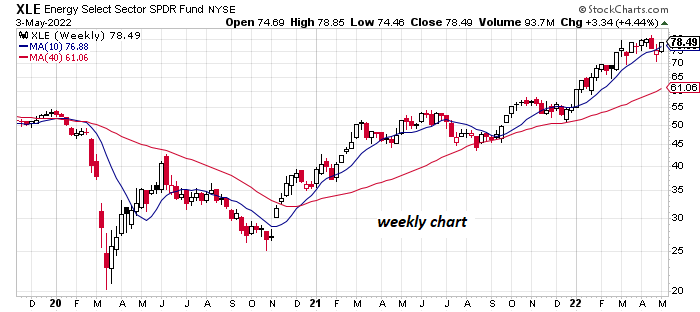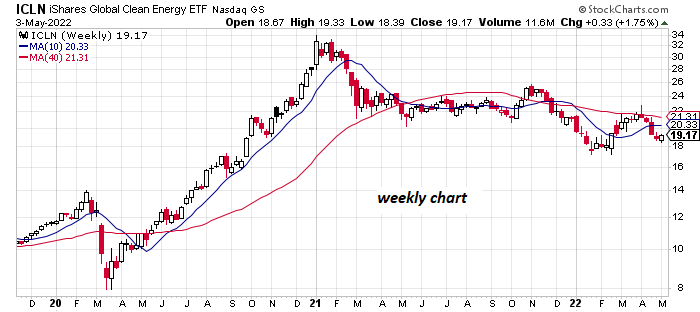U.S. Energy Shares Continue To Lead By A Wide Margin In 2022
Energy is still the only game in town for strong upside momentum in the US equity sector this year. Or perhaps a better way to explain the 2022 horse race to date: extreme divergence in favor of energy shares rolls on, based on a set of sector ETFs through Tuesday’s close (May 3).
The Energy Select Sector SPDR Fund (XLE), which is dominated by the big-oil likes of ExxonMobil and Chevron, has surged nearly 43% this year. No other US equity sector, or the stock market overall, comes close.
The ETF has wobbled lately, but the upside trend still looks intact. Indeed, a key factor that’s lit a fire for energy shares – supply disruption unleashed by the war in Ukraine – is still in place and it’s not obvious that the conflict will soon end. Add in elevated inflation that’s increasingly seen as persistent in some degree for the foreseeable future and the pieces are place for a perfect bullish storm for the energy sector.
The boon for conventional energy companies is on display this week after BP – the London-based energy giant — on Tuesday reported a blowout increase in first-quarter profit—the highest in over a decade. ExxonMobil also reported a surge in profit this week.
While the usual suspects in the business of extracting and selling fossil fuels are enjoying windfall profits lately, no one will confuse these firms with the renewable/green energy space from an investing perspective. The iShares Global Clean Energy ETF (ICLN), for example, continues to trend lower.
Meanwhile, no other US equity sector is posting a year-to-date gain at the moment, but two are close: utilities (XLU) and consumer staples (XLP), which have benefited in the current climate as relatively safe-haven equity plays, are nearly flat year to date.
Otherwise, red ink is conspicuous. The biggest loss at the moment for 2022 sector results: communication services via XLC, which has shed more than 21% this year – a loss that’s nearly twice as deep as the broad market’s year-to-date decline (SPY).
Despite the rally in big-energy stocks, some analysts say that a number of companies in the sector remain undervalued. “Energy is the only sector that is seeing quality, growth, and momentum scores improve simultaneously while maintaining an attractive value and income profile,” says JPMorgan’s Dubravko Lakos-Bujas.
Meanwhile, uber-investor Warren Buffett has recently increased purchases of energy stocks. The buys indicate that “energy is the most attractive place in the market to Warren,” advises Cole Smead, president and a portfolio manager at Smead Capital Management.
Energy shares are hardly risk-free investments. If and when the Ukraine war ends, or winds down significantly, a sharp selloff could hit the sector. There are longer-term risks as well as the world transitions to green energy. There are also concerns that rising interest rates (along with blowback from the Ukraine war) will slow the global economy, perhaps to the point of recession, which would take a bite out of energy demand.
But for the near term, at least, and perhaps longer, the supply-demand calculus still seems to favor conventional energy as Europe and Asia scramble to secure oil and gas supplies at a time of supply constraints. The US, by comparison, is largely self-sufficient for its conventional energy needs.
Nonetheless, crude oil is priced as a global commodity and so the US economy isn’t immune to international trends. As the US Energy Information Administration reasoned in mid-April, the outlook for energy and gas faces “heightened levels of uncertainty resulting from a variety of factors, including Russia’s further invasion of Ukraine.” Three weeks later, the analysis is still timely.
Disclosures: None.






